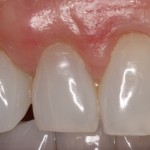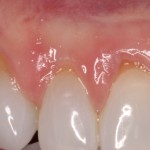“long in the tooth” or root exposure?
Have you ever heard the saying that someone is “long in the tooth”? The term was coined in 1852, and infers that a person has reached their golden years. Unlike horses, human teeth do not grow with age. Therefore, for a person to be “long in the tooth” root exposure has occurred or improperly proportioned restorative crowns or veneers have been placed. Root exposure occurs due to a single or multitude of combined contributing factors. The most common contributing factors include trauma, abnormal habits, chronic / aggressive periodontitis, tooth mal-position, orthodontic treatment, inflammation, surgical treatment , and thin gingival tissue. Root exposure caused by non-inflammatory factors can be corrected through soft tissue grafting. This is due to the biologic principle that root coverage through gum grafting is predictable when a lack of bone loss is seen between the adjacent teeth. Multiple techniques utilizing either the patient’s tissue or donor tissue have been proven as viable options. I base what technique and grafting material on classification of gingival recession, outcome prognosis, and patient preferences.
Can it be corrected?
The current patient was referred by her general dentist for evaluation of gingival recession. A clinical examination revealed exposed roots due to gingival recession. The patient expressed concern about the esthetic appearance of the recession, and how the teeth appeared longer. Secondly, the risk of increased recession and surgical goals and outcomes were discussed. I performed a soft tissue grafting procedure that utilized a Allograft Dermis with the patient comfortably sedated with I.V. sedation. The patient experienced minimal to insignificant swelling or pain post surgery. Also, the patient reports the inability to remember the procedure. This a added benefit of performing procedures under I.V. sedation. Results from the surgical procedure includes 100% root coverage with increasing the thickness of the gum tissue. Comprehensive research has shown that the thickness of gingival tissue is an important factor when anticipating the likely hood of future recession.
- Surgical treatment to correct root exposure.
- Root Exposure





 by
by 


